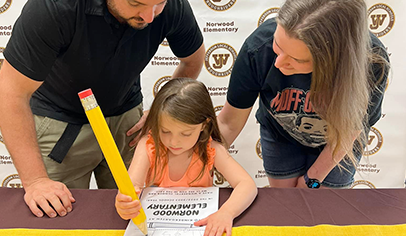Finding your way in a new school system can be a daunting task, not just for children but also for parents. Many PTOs and PTAs publish welcome packets that help orient parents by providing key information including contacts, meeting dates, and policies. However, parents often have questions that aren’t answered by reading policies or reviewing a calendar, like how to navigate the drop-off and pickup circle, what to do when you’re running late, and how to deliver forgotten homework or lunches during the school day.
A parent handbook is an excellent companion piece to the welcome packet. Different from the packet, which often includes key dates, forms, and procedures, the handbook provides less formal—but equally valuable—information for parents.
The Jefferson Elementary PTO in Redondo Beach, Calif., distributes a handbook every August to incoming families. It’s written in a casual, friendly style and includes “insider” information on the best volunteer opportunities and biggest fundraisers for the year, as well as available arts and enrichment programs and links to school calendars and newsletters. And it ends with an open invitation to contact any board member throughout the year.
Here are eight keys to creating a valuable parent handbook.
Plan ahead.
It helps to distribute the handbook a few weeks before the first day of school. As summer winds down and the days get shorter, parents start thinking ahead to school routines, and this is when they begin to have questions. Don’t wait until school starts to provide the answers or most parents will have already reached out to other sources or assumed there were no resources available. Help alleviate those first-day-of-school jitters by answering questions before they are asked.
Think like an outsider.
As a member of the PTO, you probably know your way around your child’s school as well as you know your own home. You can find the paper supplies, unjam the copiers, and track down the custodian in the boiler room. To create an effective handbook, try to remember what it was like when you were new to the school. What questions did you have but were afraid to ask? What acronyms sounded like a foreign language? What names were dropped that you couldn’t identify? Brainstorm what those questions were and aim to answer them in the handbook. Better yet, enlist a new parent to help: Early in the school year, ask a new parent to record her questions and observations and then use that list to create the next year’s handbook.
Include FAQs.
Once you’ve brainstormed and solicited all of the questions newcomers have, organize them in an easy-to-read, bulleted list of frequently asked questions. Parents will be relieved to know they are not the only ones who don’t have all the answers.
Show your face.
Maybe you have contact information on your school website, in the annual membership mailer, and in the welcome kit. That’s OK—include it here too. Make it as easy as possible for parents to reach you via phone, email, and social media. For an extra-friendly touch, include pictures of the PTO officers so that parents can identify you and say hello during the first weeks of school.
Highlight key dates.
Help keep parents informed and involved by providing an updated calendar with every communication you create. For the parent handbook, highlight key dates for the first three months of school: orientations, special education meetings, PTO meetings, and events. Be sure to update the calendar throughout the year as new programs are planned.
Collaborate.
Join with the other PTOs in your district to create a unified handbook for all of the schools. Parents with children of different ages often struggle with conflicting meetings and deadlines across the early childhood centers, elementary schools, and middle and high schools. Reach out to the other boards in town and create a districtwide PTO calendar. This will help reduce conflicting fundraisers and events and should lead to increased participation among parents and families.
Make the handbook easy to find.
Mail parents paper versions of the handbook before the school year begins. Use brightly colored paper so the handbooks won’t get lost with all the other beginning-of-the-year paperwork. Be sure to create a digital version, too. Send PDFs to your email distribution list and link to the handbook on your school or PTO website. If the handbook includes a contact list or calendar, be sure to update that piece periodically throughout the year.
Be a resource.
Many new parents don’t just need information on their child’s school; they also need help navigating youth sports groups, dance classes, music lessons, and park and recreation ac-tivities. While the difference between a Tyke and a Mite may be perfectly clear to you, a new parent often struggles with enrollment dates and age limits for youth organizations. Make your handbook an invaluable parent resource by demystifying the dates, age requirements, and registration processes for the many activities available to families in your school district.
Originally posted in 2012 and updated regularly.
























